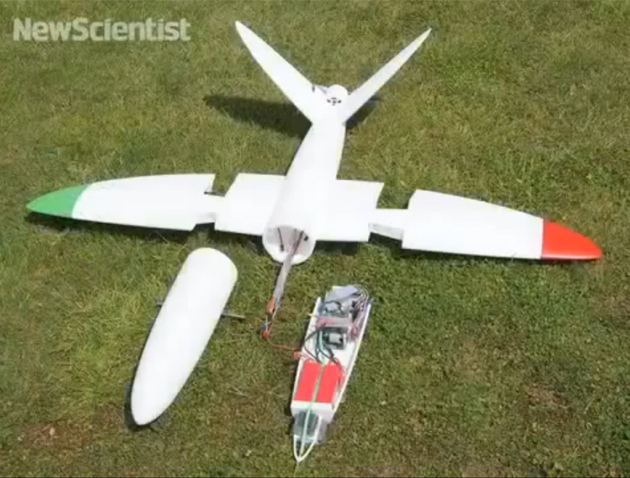HMS Protector is the Royal Navy’s sole ice patrol ship. She provides a sovereign presence in the British Antarctic territory, South Georgia and the South Sandwich Islands. These are remote regions, the home of many a penguin colony and the occasional stamp issue.
The area is represented under the banner of an appropriately themed flag:

Despite the presence of a military outpost in the Falkland Islands, it is the job of the 5,000 ton HMS Protector to fly the flag and assist in the work of the Antarctic Survey on the most inhospitable continent on the planet. In this role, she is both Research Ship and Icebreaker and is rarely seen in her home port of Plymouth.
She might not match the usual military spec but she’s certainly utilizing the latest technology available. In April 2016 she began to use drones to help navigate through the ice. A quad-copter was used for short-range reconnaissance flights. This drone captured some great footage of the ship.

The use of drones in this manner has the potential to save the MOD huge amounts of money. Putting an embarked Helo in the air for an hour costs in excess of £5000 each time. It’s plain to see that there is a huge advantage for reconnaissance flights by drones. It seems strange that the Royal Navy has recently stopped using Scan Eagle. In the long-term they save money and save the Helos for more important missions which require human oversight. These kind of drones can reduce the ‘wear and tear’ on the Lynx and Merlin aircraft, the parts of which can be costly and time consuming to fix.
The testing of drone aircraft in freezing conditions prove their operability. The crew of the Protector also tested the Southampton university laser sintered aircraft.

This drone flew for up to 30 minutes and reached a max speed of up to 60 mph. For an aircraft that costs a mere £7000 per unit it has proven itself worthy and full of plenty future potential. It doesn’t perhaps have the same endurance of a $100,000 Scan Eagle but it shows what can be achieved with some simplicity. The drone testing carried out by HMS Protector is very much in the tradition and role of the longstanding research ship, as well as the historical British presence in the region.
Drones, especially in military applications have proven to be controversial. Films such as Eye in the sky and Good Kill have highlighted the moral implications for the pilots. President Obama’s extensive use of drone strikes in Pakistan and the resulting collateral deaths, have all tarnished the use of drones in a negative light. The use of drone warfare is a philosophical debate that is endless but there are many positive applications.A cash-strapped MOD needs to use these assets in a manner to support operations and save money where it is possible. Purchased for £51 million, HMS Protector has been one of the cheaper naval purchases and a solid investment.


The Antarctic treaty,
sets aside the potential for sovereignty disputes between Treaty parties by providing that no activities will enhance or diminish previously asserted positions with respect to territorial claims, provides that no new or enlarged claims can be made … provides for inspection by observers, designated by any party, of ships, stations and equipment in Antarctica to ensure the observance of, and compliance with, the Treaty;
As a signatory of the Treaty the UK observes international law and helps to enforce it. HMS Protector allows Britain to uphold the treaty and maintain Antarctica’s unique status and protect the environment and wildlife. The Antarctic Treaty has been a successful international agreement with peaceful co-operation and agreement from the majority of parties.
The role of HMS Protector and its presence in the region can be an inspiration for all, especially the young. It places Britain at the forefront of science and research in the region. So may she continue …


Leave a comment